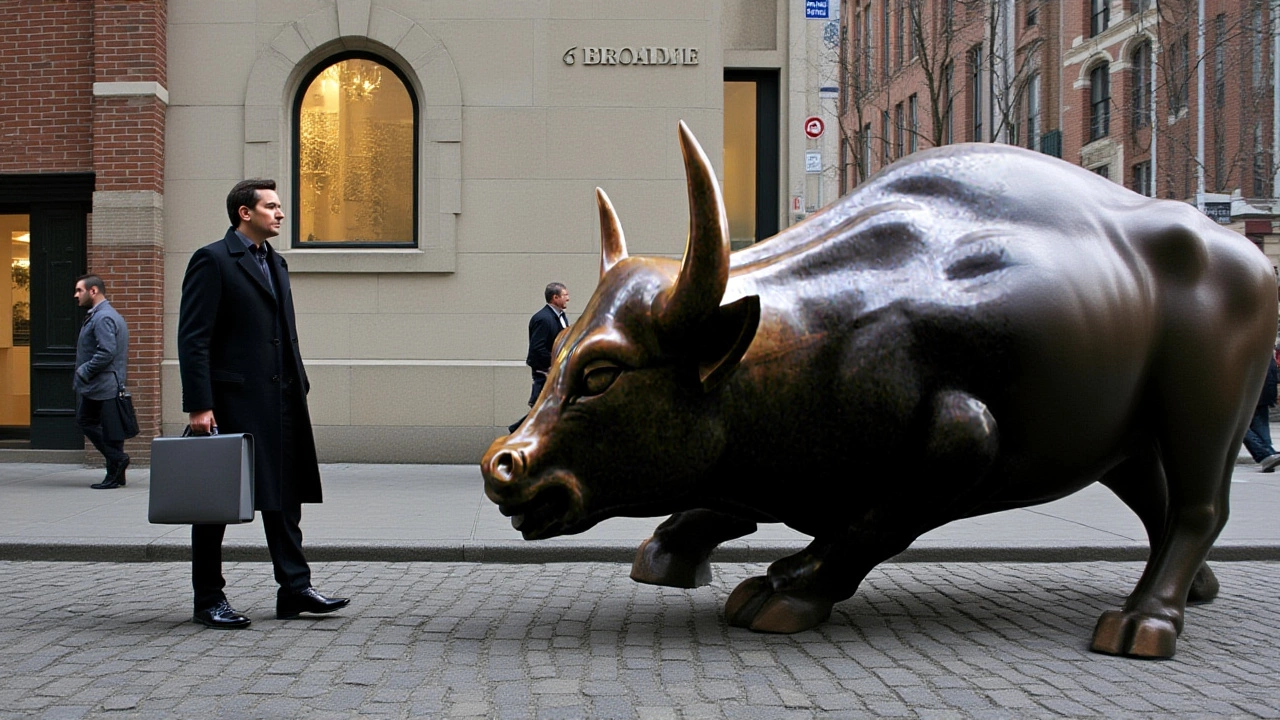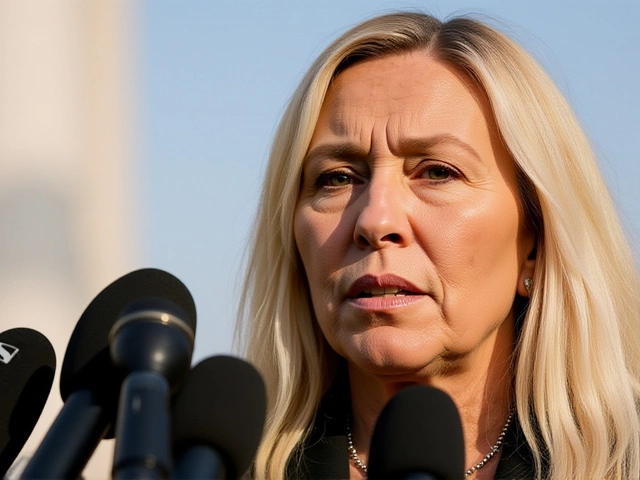U.S. equities stormed past the 6,800 mark on Tuesday, October 27, 2025, fueled by a rare convergence of trade optimism and tech-driven momentum — a rally so sharp it left even seasoned traders nodding in disbelief. The surge, centered on the NASDAQ Composite, came during regular trading hours at New York Stock Exchange, as investors reacted to signals from Washington and Beijing that a long-stalled trade deal was finally within reach. The move wasn’t just about numbers; it was about trust — restored, however tentatively, between the world’s two largest economies.
Why Tech Was the Engine — and the Weight
The NASDAQ Composite didn’t just climb — it carried the market on its back. Year-to-date through October 27, it had gained 18.7%, far outpacing the S&P 500’s 12.3% and the Dow’s 9.8%. That’s not just leadership; it’s dominance. As one unnamed guest on Bloomberg Television’s 'The Close'New York City put it: "IT’S GOING TO BE MAKE OR BREAK IN TERMS OF WHAT THE TECH COMPANIES DO THIS WEEK. THE TECH SECTOR HAS BEEN DOING AN ENORMOUS AMOUNT OF HEAVY LIFTING." And they were right. Apple, Microsoft, NVIDIA, and Alphabet didn’t just post earnings — they rewrote expectations. Investors weren’t just buying stocks; they were betting on AI infrastructure, cloud spending, and semiconductor demand holding strong even as global uncertainty lingered.Trade Deal Momentum: Tariffs, Shipping, and Chips
Behind the numbers was a quiet but critical breakthrough. Negotiators from the Office of the United States Trade Representative in Washington, D.C. and China’s Ministry of Commerce in Beijing had reached tentative agreements on three key fronts: reducing Section 301 tariffs imposed since July 2018, revising shipping fee structures under the Federal Maritime Commission, and establishing new export control protocols for advanced semiconductors. The handshake imagery — real or symbolic — mattered. Markets don’t just react to policy; they react to perception. And perception had shifted.That optimism didn’t just lift tech. It sent MAXIM — the U.S. shipping firm — soaring to its biggest one-day jump in weeks. Why? Because if goods flow again, freight moves. Meanwhile, the inverse happened in commodities. Precious metals and rare earth stocks, which had ridden a 22.5% and 31.7% rally since September, gave back 4.2% and 6.8% respectively on October 27. Barrick Gold and MP Materials didn’t collapse — they corrected. Investors were rotating out of safe havens and into growth.

Emerging Markets Get a Double Boost
The ripple effects were global. The MSCI Emerging Markets Index hit 1,245.80 on October 27 — its highest close since December 31, 2021. Why? Three reasons. First, the U.S.-China thaw reduced fears of a global trade freeze. Second, investors priced in a Federal Reserve rate cut — the third of 2025 — scheduled for Wednesday, October 29, at 2:00 PM Eastern Time in Washington, D.C.. And third? Argentina.On October 20, 2025, voters in Argentina delivered a decisive win to the market-friendly Juntos por el Cambio coalition, led by President Javier Milei. The coalition now holds 56 of 257 seats in the Chamber of Deputies, signaling a path toward fiscal discipline. Emerging market investors, long wary of Latin American volatility, saw a rare signal of stability. "It’s not just trade," said Tarun Ramadorai, Professor of Financial Economics at the Reserve Bank of India. "It’s the alignment of monetary easing, trade de-escalation, and political credibility — all at once. That’s the trifecta emerging markets haven’t seen since 2019."
What Comes Next? Fed, Signing, and Earnings
The rally isn’t over — it’s just entering its next phase. The Federal Open Market Committee meeting on October 29, 2025, will be the next litmus test. If the Fed cuts rates as expected, it’ll validate the market’s forward-looking optimism. If they hold, the rally could stall — especially in tech, where valuations are stretched.Then there’s the signing. On November 15, 2025, U.S. and Chinese officials are scheduled to formally ink the trade framework in Geneva, under WTO auspices. That’s not just symbolism. It’s legal scaffolding. Until then, markets will remain on edge. One misstep — a tariff reversal, a chip export denial, a political gaffe — could unravel weeks of progress.

The Bigger Picture: A Market Reborn?
This rally feels different. It’s not just about cheap money or AI hype. It’s about a system recalibrating. After years of decoupling, sanctions, and suspicion, there’s a quiet realization: the world still needs each other. American consumers need Chinese factories. Chinese tech needs American chips. Shipping lanes need stability. And investors? They need certainty.That’s why the NASDAQ Composite crossing 6,800 isn’t just a number. It’s a mood. A collective exhale. A belief — fragile, yes — that diplomacy still works. The real test won’t come on Wall Street. It’ll come in Beijing, in Washington, and in the quiet rooms where negotiators decide whether this deal is real… or just another false dawn.
Frequently Asked Questions
How did the U.S.-China trade talks directly impact U.S. stocks on October 27, 2025?
The talks triggered a broad market rally by signaling progress on tariffs, shipping fees, and semiconductor export controls — three major pain points since 2018. Investors interpreted the tentative agreements as reducing global economic friction, which boosted tech stocks (especially AI and chipmakers) and shipping firms like MAXIM. The optimism also reduced demand for safe-haven assets like gold, causing those sectors to pull back.
Why did emerging markets surge even before the Fed’s rate cut?
Emerging markets rallied due to a three-part catalyst: U.S.-China trade easing reduced fears of global slowdowns, Argentina’s pro-market election outcome signaled political stability in a key EM nation, and anticipation of a Fed rate cut on October 29 made dollar-denominated assets more attractive. The MSCI EM Index hit 1,245.80 — its highest since 2021 — showing investors were betting on synchronized global easing.
What role did the Federal Reserve play in the October 27 rally?
While the Fed didn’t act on October 27, its upcoming rate cut — the third of 2025 — was a major driver. Investors priced in a 78% probability of a 25-basis-point cut on October 29, lowering the cost of capital and boosting growth stocks. This expectation, combined with trade optimism, created a powerful tailwind for equities, especially in tech and emerging markets where borrowing costs matter most.
Why did precious metals and rare earth stocks fall despite the broader rally?
They were correcting after sharp gains during September–October 2025, when investors fled to gold and rare earths amid trade fears. As U.S.-China tensions eased, demand for these safe-haven assets dropped. Barrick Gold fell 4.2% and MP Materials dropped 6.8% on October 27, reversing roughly half of their combined 54% rally over the prior six weeks. This was a rotation, not a collapse.
Is the NASDAQ’s performance sustainable after this rally?
Sustainability hinges on earnings. The NASDAQ’s 18.7% YTD gain through October 27 is the highest among major indexes, but valuations are elevated. If tech giants like NVIDIA and Microsoft deliver strong Q4 results next month, the rally can hold. If they miss, the market could see a sharp pullback. Analysts warn that the sector is now more vulnerable to any sign of slowing AI spending or regulatory scrutiny.
What’s at stake in the November 15 trade agreement signing in Geneva?
The signing isn’t just ceremonial — it’s the first formal step toward turning verbal agreements into binding rules. If the framework includes enforceable mechanisms on tariffs and export controls, it could restore supply chain confidence. If it’s vague or lacks enforcement, markets may see it as a temporary reprieve, not a resolution. Investors are watching closely for details on semiconductor controls — the most sensitive issue.





